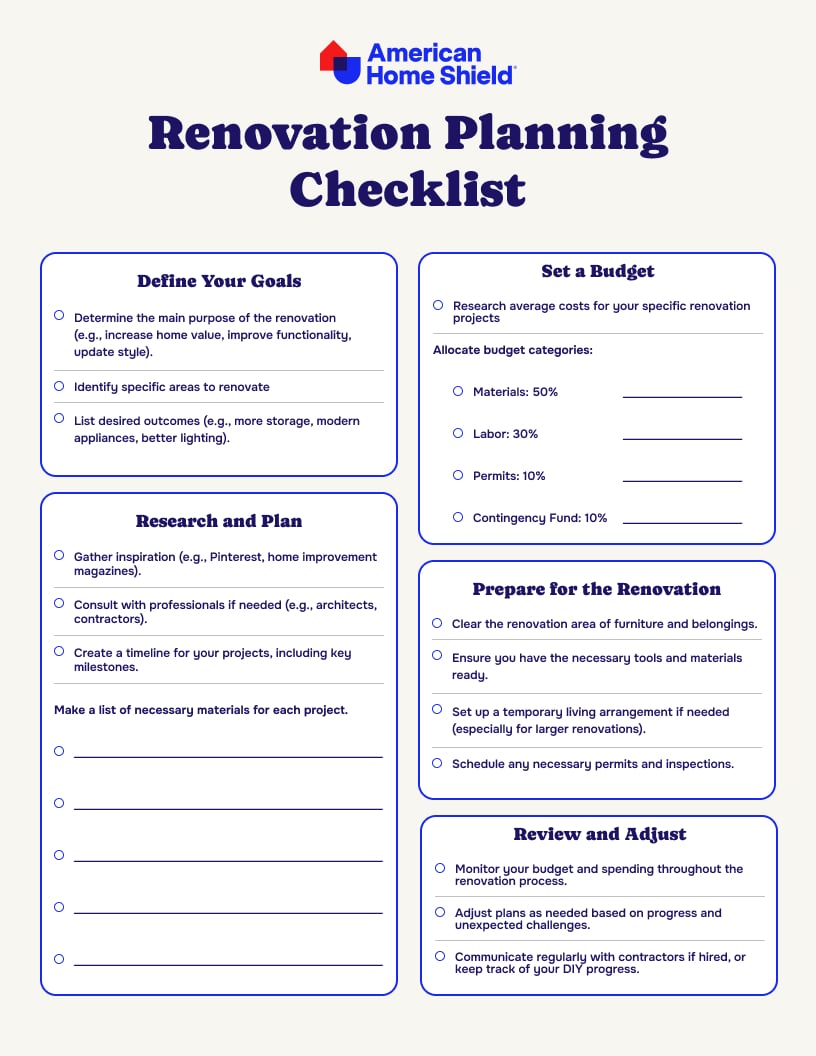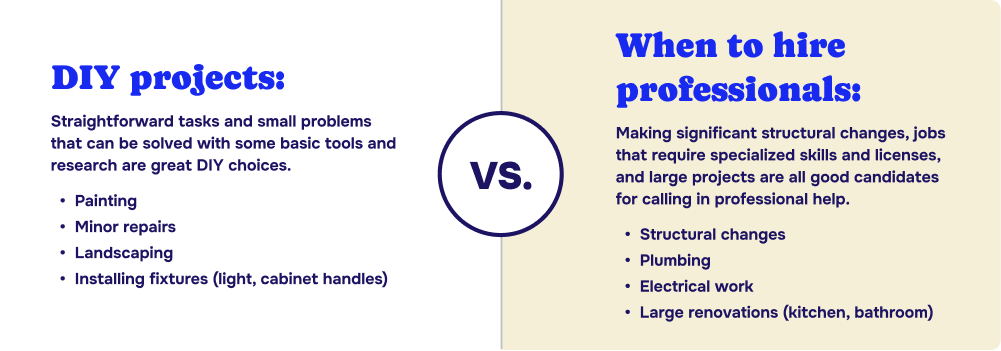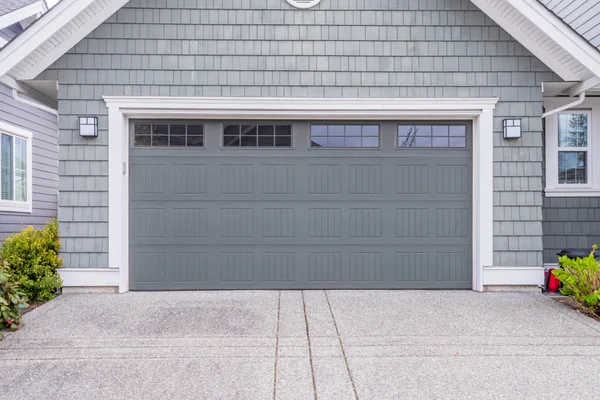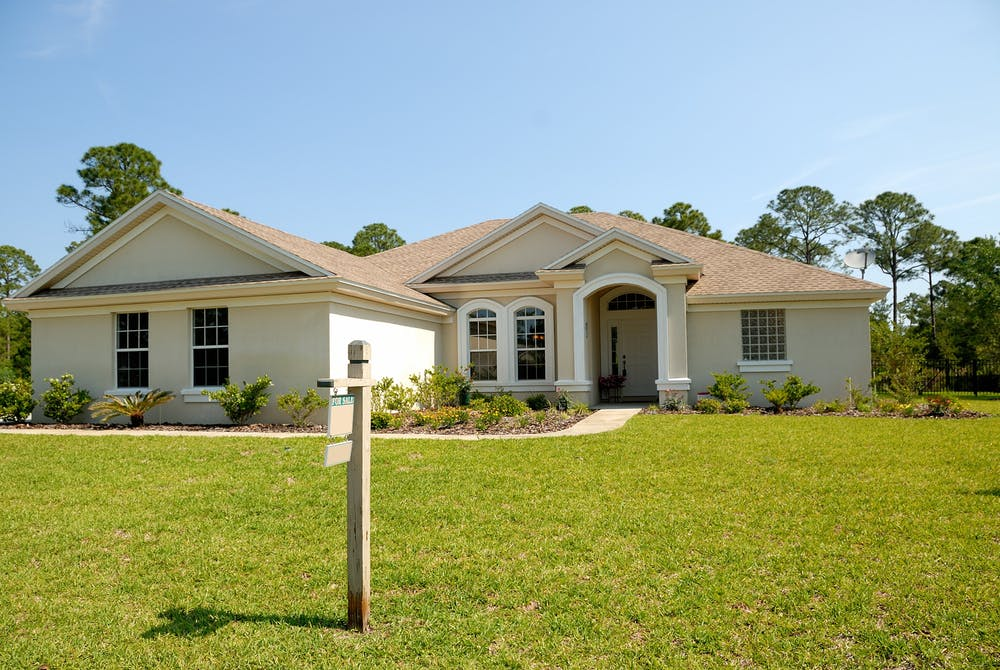While home renovation comes with its challenges—like navigating permissions, regulations, and making countless decisions—it presents an opportunity to bring your creative vision to life. Making a plan that balances cost-efficiency and design gives you peace of mind and allows you to make thoughtful choices about where to invest and where to save. At the end, you’ll be one step closer to your dream home!'
Follow along to learn how to create a basic budget for home renovations with our handy home improvement planner.
Setting a realistic home renovation budget
The key to making the most of your renovations budget is making sure that you set a realistic budget in the first place. It helps to understand the typical costs of the renovation you’re looking to do. Here’s a breakdown of some popular projects and their typical price ranges:
- Kitchen Remodel: Expect to spend between $13,000 and $37,000 depending on the size and finishes you choose.
- Bathroom Renovation: This usually costs between $6,000 and $15,000, with luxury options potentially hitting $30,000.
- Deck Addition: Building a new deck can range from $2,000 to $10,000, based on size and materials.
- Basement Finishing: This can set you back $20,000 to $50,000, depending on the complexity of the project.
How to allocate your home renovation budget
Now that you’ve got a ballpark of what a renovation should cost, it’s time to think through the costs that are specific to your project. Specifically consider your materials costs, labor costs, permits costs, and some extra as a contingency fund.
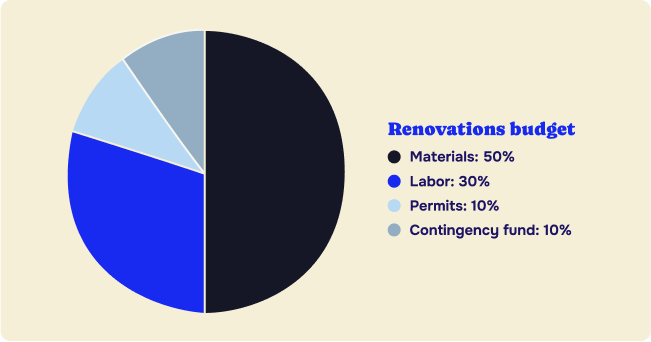
Why this allocation matters:
- Materials (50%): Good materials are usually worth the cost. Investing in quality materials ensures that your renovations look good and will stand the test of time. Look for ways to save here by shopping sales or considering alternative materials.
- Labor (30%): Depending on your skill level and the complexity of the project, labor costs can take a big bite out of your home renovation budget. Seek home help from professionals for the more complex tasks, but also weigh which tasks you can tackle on your own to save some cash.
- Permits (10%): Permits can range from a few hundred to several thousand dollars depending on where you live. Always check local regulations and include this cost in your initial budget to avoid any surprises down the road.
- Contingency Fund (10%): Life is unpredictable, and renovations are no different! Setting aside a contingency fund makes sure that you’re prepared for any unexpected costs that arise, whether it’s structural issues or price hikes in materials.
Take a second to use this renovation budget template to make your own calls about allocation to help yourself stay on track and avoid financial pitfalls during your renovation journey.
Cost-effective renovation ideas
If you’re looking to make a change without breaking the bank, consider a low-lift, low-cost renovation that makes your space feel new. These projects can breathe new life into your home without draining your wallet:
- Fresh Paint: Repainting the walls is a great way to utterly transform the feel of any room. On average, painting a 1,500 square feet home can cost around $2,000.
- Update Fixtures and Hardware: Swapping out outdated light fixtures, cabinet handles, and faucets can give your space an instant facelift. This project can often be done for under $1,000.
- Tiling a Backsplash: Adding a new backsplash in the kitchen is a stylish way to elevate your cooking space without a complete remodel. Expect to spend around $1,500 for materials and installation, depending on the cost of materials and size of space.
- Landscaping: Upgrading your yard is a great way to boost your home’s appeal and can be achieved for about $4,500. Simple upgrades like planting flowers, adding mulch, or installing a decorative border make a big difference.
- Updating a Fireplace: Refreshing your fireplace can be a game-changer in your living room. Whether you choose to paint the mantel, add new tile or stone facing, or replace the insert, you can complete this project for around $2,500.
- Bathroom Refresh: Rather than doing a full renovation, refresh your bathroom by replacing the vanity, mirror, and light fixtures. You can achieve a new look for around $3,000 without the hassle of a complete overhaul.
- Energy-Efficient Upgrades: Installing energy-efficient windows or upgrading insulation can have a higher upfront cost but may lead to savings on your energy bills.


